Management Accountability Framework 2017-18 Departmental Report
On this Page
- Executive Summary
- Financial Management
- People Management
- Information Management and Information Technology Management
- Results Management
- Security Management
- Service Management
- Annex: Operational Context
Executive Summary
Departmental Performance
For the Management Accountability Framework 2017-18 cycle, the Canadian Food Inspection Agency (CFIA) was assessed on the following core Areas of Management (AoM): Financial Management, People Management, Information Management and Information Technology (IM/IT) Management, and Results Management. CFIA was also assessed on two department-specific AoMs: Security Management and Service Management.
The Treasury Board of Canada Secretariat (TBS) notes solid management performance for CFIA in the following area:
- Diverse and Inclusive Workplace (People Management): A majority of employees (79%) either strongly or somewhat agreed that their agency implements activities and practices that support a diverse and inclusive workplace.
CFIA has made progress in the following priority areas since last year's Management Accountability Framework assessment:
- Management of Electronic Information (Information Management and Information Technology (IM/IT) Management): CFIA has improved its management of electronic documents, a management priority following Management Accountability Framework 2016-17. With the implementation of its Shared Drives Cleanup initiative, CFIA now manages 17.2% of its electronic information resources in corporate repositories, a significant improvement compared to previous Management Accountability Framework cycles (6% or less since 2014-15). This initiative is expected to continue and TBS anticipates that there will be continued improvement in this area in future years.
- Mission Critical Applications (Security Management): All of CFIA's mission critical applications in operation have been assessed for security risks, an improvement from last cycle (81% in 2016-17). TBS notes that these applications are operating "under conditions," which indicates that identified security risks have not been mitigated or are higher than acceptable for on-going operations. CFIA is encouraged to focus on continuing to implement measures to mitigate these risks. Mission critical applications are those that, if compromised or unavailable, have the potential to cause a high degree of injury to the health, safety, security or economic well-being of Canadians, or to the effective functioning of government.
Management Priorities
The following Management Accountability Framework 2016-17 management priorities continue to require attention for the 2018-19 Management Accountability Framework cycle:
- Low Adjusted Operating Lapses (Financial Management): CFIA continues to manage through low adjusted operating lapses. This metric was not measured in Management Accountability Framework this year. TBS notes that CFIA is carefully monitoring its operating vote, with only 1.3% variance between its mid-year forecast and the year-end position in 2016-17. TBS encourages CFIA to continue exercising diligence in overseeing its operating expenses.
- Service Standards (Service Management): CFIA has worked with TBS to begin addressing the service management challenges that were flagged in previous Management Accountability Framework reports. In 2016-17, CFIA launched the AskCFIA service and MyCFIA portal. It created National Service Centres to simplify processes for clients to request licenses to operate and permission to import. Despite these improvements, CFIA continues to demonstrate low overall performance in the area of Service Management. TBS encourages CFIA to establish and monitor clear service standards and meet its related targets for its services (it is currently not meeting any of its targets). TBS also encourages CFIA to increase the services that can be completed online from end-to-end (currently 6%), and to improve its services based on client feedback.
Financial Management
The 2017-18 Management Accountability Framework assessment for the Financial Management (FM) Area of Management (AoM) is designed around the principles of modern comptrollership, which is defined as "enabling innovation and results by balancing control and flexibility". The overall objective of the Management Accountability Framework assessment for this AoM is to assess compliance and monitor progress towards the implementation of key requirements in the renewed FM policy suite and to assess financial management practices and performance in key areas.
Resource Management
The effective management of public funds depends on the collection of reliable data and the availability of sound financial information for decision making.
Identification and Assessment of Multi-Year Financial Risks
The early identification and assessment of multi-year financial risks is critical to determining the long-term financial sustainability of an organization and ensuring that there is sufficient time to respond to and manage any financial risks. The Policy on Financial Management requires that organizations adopt a multi-year perspective when identifying and assessing financial risks as part of their approach to financial planning and budgeting. In addition, organizations must communicate and integrate financial management elements, including multi-year financial risks, within their governance structures.
The evidence submitted by the Canadian Food Inspection Agency (CFIA) demonstrated that it proactively assesses multi-year financial risks associated with projected salary expenditures, budgetary changes, revenues, and funding pressures. CFIA provided evidence that demonstrated that a governance structure routinely and proactively assesses current and multi-year financial risks.
CFIA noted that its regulatory services have always been very stable and therefore revenues do not materially fluctuate from year-to-year.
Timing of Initial Budget Allocation
Earlier access to budgets allows managers to plan their program delivery and financial strategies in a more effective and timely manner. Department or agency managers should have access to their budgets within 30 days of the start of the fiscal year.
Number of calendar days for lowest level managers to get access to their approved budget (Q6)
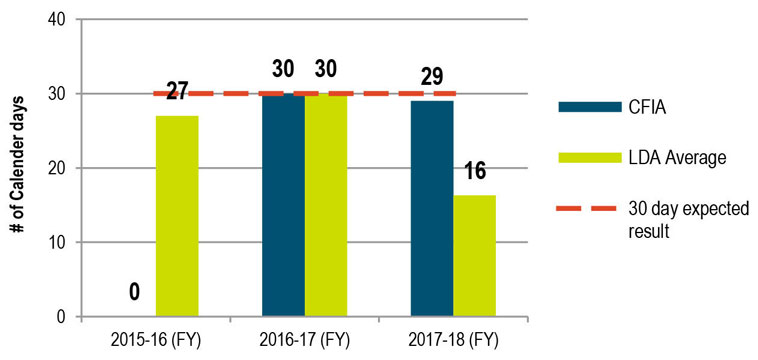
Description for Number of calendar days for lowest level managers to get access to their approved budget (Q6)
| Fiscal Year | Large Departments and Agencies Average | CFIA |
|---|---|---|
| 2015-16 | 27 | 0 |
| 2016-17 | 30 | 30 |
| 2017-18 | 16 | 29 |
CFIA provided managers at the lowest levels with access to their approved budgets 29 days after the start of the 2017-18 fiscal year, which is consistent with the previous year.
Forecasting Accuracy
Departments and agencies should ensure sound financial information (including accurate forecasts of the year-end position) is prepared and communicated to senior management. This information enables senior management to take appropriate and timely resourcing decisions.
Below is the summary of CFIA's actual lapse at year end and forecasted lapse by period and by vote:
CFIA lapsed 3% of its operating vote at year-end when compared to its P6 forecast of 2% and its P9 forecasted lapse of 2%.
CFIA lapsed 41% of its capital vote at year-end when compared to its P6 forecast of 22% and its P9 forecasted lapse of 34%.
Internal Control Management
Internal controls are a set of measures and activities that provide reasonable assurance of the effectiveness and efficiency of the FM activities of the organization.
Risk-based Ongoing Monitoring Program
The Policy on Financial Management requires that deputy heads ensure the maintenance of effective internal controls over financial management in order to mitigate risks to programs, operations, and resource management. This includes the implementation of an ongoing risk-based monitoring plan for future year assessments, that is documented and followed, to ensure organizations are effectively monitoring their internal controls over financial reporting.
CFIA is continuously monitoring the effectiveness of its internal controls over financial reporting as demonstrated by its documented risk-based ongoing monitoring plan. CFIA is encouraged to maintain the progress it has made in this area and to continue participating in the Internal Control Working Group.
Reconciliation of Salary Expenditures
The reconciliation of actual salary expenditures within organizational financial systems against forecasts is a key control to ensure that salary expenditures are accurate and that any variances are reported on a timely basis. Organizations should ensure that salary expenditures are reconciled on a regular basis with the expectation that they are reviewed at least quarterly.
CFIA has demonstrated that salary expenditures are reconciled against salary forecasts on a quarterly basis and is encouraged to maintain the salary reconciliation process it has in place.
Delegation of Travel Approval Authorities
The Directive on Travel, Hospitality, Conference and Event Expenditures provides flexibility to departments and agencies to delegate travel approval authority below the senior departmental manager level, when there is an operational need to do so. Departments and agencies must review their travel delegations and align them with their operational needs.
CFIA determined that there is an operational need to delegate travel approval authorities to levels below the senior departmental manager and, as a result, revised its delegation chart.
Payment on Due Date
The Directive on Payments requires that suppliers of goods and services are paid on the due date. In most cases, the standard 30-day payment term is used and starts as soon as an invoice is received, or the goods and services are accepted, whichever is later. The late payment of invoices has been identified as an issue that negatively impacts suppliers and, in particular, small businesses. Departments and agencies should pay all suppliers on time.
Timeliness of payments to suppliers (Q23)

Description for timelines of payments for suppliers
| Fiscal Year | Percent |
|---|---|
| 2014-15 | 96.0 |
| 2015-16 | 97.6 |
| 2016-17 | 99.3 |
In 2016-17, CFIA paid 99.3% of its payments to suppliers on time. The timely payments to suppliers represents a slight increase compared to the previous year and demonstrates strong results in this area.
Management of Accounts Receivable
The Directive on Public Money and Receivables requires that departments recognize and record receivable transactions in departmental accounts and take appropriate, timely, and cost-effective collections actions. The aging of accounts receivable indicates the length of time that money has been owed to the Crown.
Aging of gross non-tax accounts receivable as of March 31st, 2017 (Q24-28)

Description for Aging of gross non-tax accounts receivable as of March 31st, 2017 (Q24-28)
| Title | Percent |
| Not past due | 94.8 |
| 1-30 days | 1.4 |
| 31-60 days | 0.7 |
| 61-90 days | 0.2 |
| 91-365 days | 0.8 |
| Over 365 days | 2.2 |
As of March 31, 2017, 2.2% (or $238K) of CFIA's accounts receivable were outstanding over 365 days. CFIA is encouraged to continue actively pursuing the collection of its accounts receivable and when the debts are deemed uncollectible, timely action should be taken for the write-off, remission, forgiveness, or waiving of debts.
Financial Community Capacity
Succession planning and the professionalization of the FM community are essential to supporting a strong and sustainable financial management function.
Succession Planning
The Policy on Financial Management requires that succession plans are in place to identify potential resources to meet the future demands of critical FM positions. Effective succession plans demonstrate a continuing capability to lead the organization's FM workforce.
CFIA has established an internal succession plan for its critical financial management positions.
Professionalization of the FM Community
The recruitment of individuals who possess a CPA designation and supporting existing employees in their pursuit of a CPA designation contributes to the professionalization of the FM community and the development of a high-performing workforce.
Within CFIA's financial management community, 46% of staff are either pursuing or possess a Chartered Professional Accountant designation or have completed the Senior Executive Advanced Finance and Accounting Program. CFIA is encouraged to continue engaging and growing its talent to achieve a 1% improvement year over year.
People Management
Effective people management is a cornerstone of a high-performing public service and a key enabler in building Canadians' trust in government. Significant progress in modernizing human resources has been made in recent years in the Public Service of Canada. The objective of this Area of Management (AoM) is to assess people management practices and performance across the public service to provide deputy heads and heads of human resources with information on trends and issues, and to enable the development of evidence-based people management strategies.
The 2017-18 People Management methodology is comprised of measures organized around three areas: Workforce; Work Culture; and Structures and Processes. Results from employee surveys, such as the Public Service Employee (Annual) Surveys, will be used as contextual information, where applicable.
Workforce
The Government of Canada is committed to developing a highly skilled and diverse workforce, capable of serving the public in both official languages. Sustaining a culture of high performance in the public service is a shared commitment between managers, employees and their organizations. The Performance Management Program (PMP) for executives encourages excellence in performance and strives to improve organizational results.
Talent and Performance Management, Learning and Development
The Directive on Performance Management and the Directive on the Performance Management Program for Executives requires all employees to have annual documentation setting performance objectives, learning plans, mid-year reviews and performance assessments. Successful performance management facilitates the effective delivery of an organization's strategic and operational goals. It also provides the space for ensuring that employees know what is expected of them and that they have tools to do their jobs.
Percentage of non-executives with performance objectives, learning and development plans, mid-year discussions and completed assessments in Fiscal Year 2016-17 (Q1, Q3, Q5, Q7)
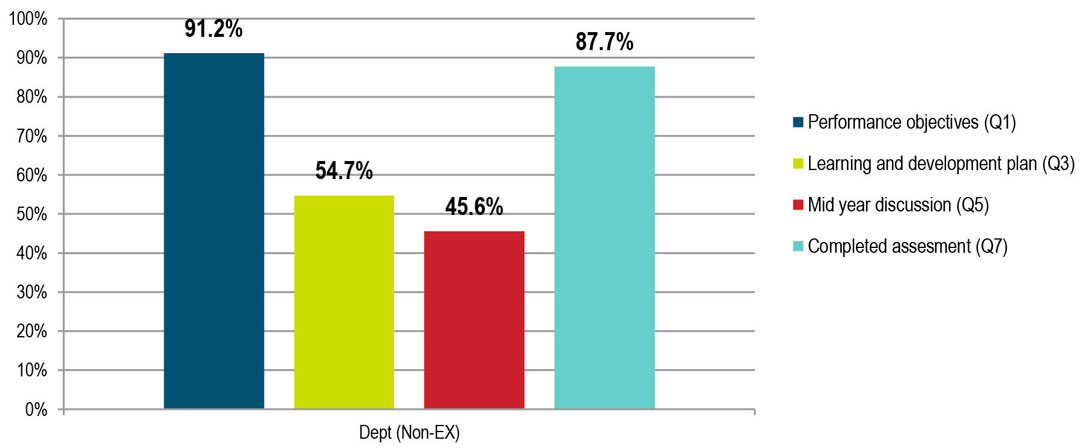
Description for Percentage of non-executives with performance objectives, learning and development plans, mid-year discussions and completed assessments in Fiscal Year 2016-17 (Q1, Q3, Q5, Q7)
| Title | Percent |
|---|---|
| Performance objectives | 91.2 |
| Learning and development plans | 54.7 |
| Mid-year discussion | 45.6 |
| Completed assessment | 87.8 |
Ratings on overall performance agreements of non-executives for Fiscal Year 2016-2017 (Q9 to Q13)
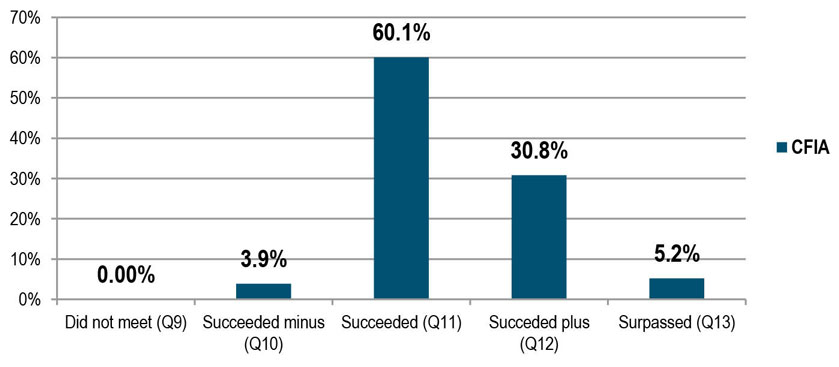
Description for Ratings on overall performance agreements of non-executives for Fiscal Year 2016-2017 (Q9 to Q13)
| Performance Rating | Percent |
|---|---|
| Did not meet | 0 |
| Succeeded minus | 3.9 |
| Succeeded | 60.1 |
| Succeeded plus | 30.8 |
| Surpassed | 5.2 |
At the Canadian Food Inspection Agency (CFIA), in fiscal year (Fiscal Year) 2016-17, a majority of non-executives had documentation setting performance objectives, learning and development plans, mid-year discussions with their immediate supervisors to review performance, and completed performance assessments. As a Separate Employer, CFIA does not use the Public Service Performance Management Application (PSPMA). As in previous years, the Agency used a random, representative sample to estimate the participation of its non-executives in the performance management process. In addition, CFIA does not make it mandatory to record mid-year conversations.
Compared to Fiscal Year 2014-15, a decrease is observed for non-executives in setting learning and development plans as well as mid-year discussions. A significant improvement is observed in setting performance expectations and completion of performance assessments.
As this is a baseline year for gathering information, performance management for executives is not being assessed.
CFIA uses a five-point rating system that aligns well with the PS rating system, however, the terminology is different. Of non-executives who had completed performance assessments, 96.1% met or exceeded set expectations, while just under 4% need to improve to meet their work objectives. Note: Non-executives who were deemed 'unable to assess' were not included in the Management Accountability Framework results. As a result, the total may not add up to 100%.
According to the 2017 Public Service Employee Survey (PSES), 61% of CFIA's employees agree that they get the training they need to do their jobs, up from 58% in the 2014 PSES. The public service average for this measure increased from 63% in 2014 to 66% in 2017. Similarly, 73% of CFIA's employees agree that they receive useful feedback from their immediate supervisors on their job performance, similar to the 2014 PSES (71%). The public service average for this measure is 73%.
Official Languages
Organizations are expected to create, reflect and maintain a work environment that is conducive to the use of both official languages and where employees are encouraged to use the official language of their choice in the workplace. Employees play a vital role in fulfilling their organization's official language obligations when providing services to, or communicating with, the public and other employees. The organization's leaders lead by example by promoting these objectives. The measures on official languages indicate the extent to which departments and agencies meet the requirements of the Policy on Official Languages.
CFIA indicated that the linguistic profiles of bilingual positions often (between 50% and 69% of cases) reflect the duties of employees or their work units, as well as the obligations with respect to service to the public and language of work.
At CFIA, when the office is designated bilingual, service to the public occurs in the official language chosen by the public very often (between 70% and 89% of cases) in written and in oral communications.
Nearly 71% of CFIA's executive cadre had up-to-date second language evaluation (SLE) results, a decrease of almost three percentage points from the previous year. However, only 57% of non-executives in bilingual positions that communicate with and serve the public had up-to-date SLE results. CFIA notes that all its executive positions are at the CBC level.
Workplace Culture
The Government of Canada is committed to sustaining an ethical workplace that is respectful, diverse, healthy, and free of harassment and discrimination. Employee surveys such as the PSES and the Public Service Employee Annual Survey (PSEAS) provide employees with the opportunity to express their views on the health of their workplace. Results from these surveys help shape corporate management priorities and generate concrete actions in support of an ethical, high performing, and engaged public service.
Departments and agencies are responsible for taking action on issues raised in the surveys by putting solutions in place.
CFIA identified diversity, mental health and well-being, harassment, and discrimination as top priorities for action after analyzing results from the previous survey.
Values and Ethics
Departments and agencies are responsible for integrating departmental values and ethics priorities into their corporate activities so that those values become living principles, practiced every day in the workplace. Departments and agencies are also responsible for taking actions to create and support a workplace free from reprisal.
Similar to last year, CFIA continues integrating its departmental values and ethics (V&E) in its Departmental Audit Program and Evaluation Program. CFIA has also appointed a V&E champion and encourages the formation of V&E networks/working groups. Similar to last year, CFIA integrated V&E in its Corporate Risk Profile.
CFIA strives for a workplace where employees feel protected from reprisal by mandating training on V&E for employees, offering leadership training to foster an ethical culture, and conducting workshops and information sessions. CFIA also ensures that mechanisms for reporting and resolving concerns raised in the workplace are easily accessible.
According to the 2017 PSES, 18% of CFIA's employees indicated that they were victims of harassment, similar to the 2014 PSES results (19%) and the same as the 2017 PSES average. Also, 9% of CFIA's employees indicated that they were victims of discrimination, which was the same as the 2014 PSES results, and similar to the 2017 PSES average (8%).
Even though CFIA indicated that it did not appoint a recognition champion, it set out evaluation criteria for awards, dedicated a budget for recognition, identified a contact person, and held a range of formal and informal recognition activities.
Diversity and Inclusion
Departments and agencies are responsible for fostering diversity and inclusion in the workplace. To this end, organizations need to show leadership and demonstrate that concrete actions are taken to support the creation of an inclusive workplace where employees feel respected and welcomed regardless of their identities, abilities, backgrounds, cultures, skills, perspectives and experiences. An inclusive workplace is fair, equitable, supportive, welcoming and respectful. It supports and reinforces Canada's evolving human rights framework.
Ensuring diversity and inclusion will lead to better decisions, the ability to attract and retain the best talent from all generations, and ultimately better results for Canadians.
According to the 2017 PSES results, 79% of CFIA's employees agreed that the Agency implements activities and practices that support a diverse workplace, a decrease of four percentage points from the 2014 PSES results. Similar to last year, CFIA's efforts cover a broad spectrum of activities, such as mandating training on Diversity and Inclusion (D&I), appointing a champion for D&I, and holding various Agency-wide activities. The Agency has also included D&I in its human resources strategic plans and developed strategies to recruit members of designated employment equity groups.
To increase recruitment of Indigenous students, CFIA has reached out to various Indigenous career groups to organize informal meet-and-greet sessions, which resulted in an increase in the number of Indigenous student hires. CFIA has also created a streamlined application process for Indigenous students, where CFIA representatives attend and participate in Indigenous student-specific post-secondary events across the country.
Mental Health and Wellness
The public service must show leadership in building a healthy, respectful, and supportive work environment where concrete actions are taken to support open and stigma-free dialogues on mental health.
Organizations need to instill a culture that enshrines psychological health, safety, and well-being in all aspects of the workplace through collaboration, inclusivity, and respect.
According to the 2017 PSES results, 56% of CFIA employees agreed that their workplace is psychologically healthy, the same as the 2017 PSES average. Nineteen percent of CFIA employees indicated that their stress level is high while 27% signalled that after the workday they feel emotionally drained.
CFIA is undertaking necessary steps towards the prevention of psychological harm due to workplace factors. The Agency completed a review of existing programs, policies, and workplace practices that influence psychological health and safety. It did not indicate that it performed a joint psychological analysis with bargaining agents or prioritized identified hazards.
At CFIA, it takes 39.2 days on average to submit the Employer Report of Injury to Employment and Social Development Canada.
The number of paid sick days per Full Time Equivalent is a key metric that provides useful information for the management of sick leave in the federal public service and the development of wellness strategies in the workplace.
Paid sick leave usage in days - as of March 31st 2017 (Q32 to Q34)
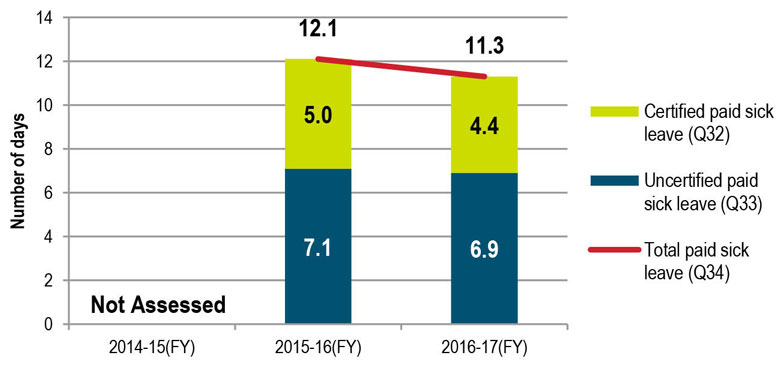
Description for Paid sick leave usage in days - as of March 31st 2017 (Q32 to Q34)
| Fiscal Year | Certified sick leave | Uncertified sick leave | Total paid sick leave |
|---|---|---|---|
| 2014-15 | Not assessed | Not assessed | Not assessed |
| 2016-17 | 7.1 | 5.0 | 12.1 |
| 2017-18 | 6.9 | 4.4 | 11.3 |
The usage of paid sick leave at CFIA has been trending down over the last two years.
Structure and Processes
The public service needs efficient and effective processes, tools, practices, and organizational structures to support clear decision-making and accountability.
The Directive on Executive (EX) Group Organization and Classification requires that departments have no more than three layers of positions classified in the executive group below the Deputy Head/Associate Deputy Head.
Organizational charts provide guidance and clarity on the line of authority and responsibility in the organization. CFIA publishes its executive organizational chart on its website and limits the layers of executive in direct line to the deputy head to three layers.
CFIA's EX distribution by level is comparable to that of other large departments and agencies (LDA), although unlike in other LDAs, the number of incumbents at EX-02 level (50) is high comparing to EX-01s (67).
EX distribution by level - Fiscal Year 2016-2017 (Q22)
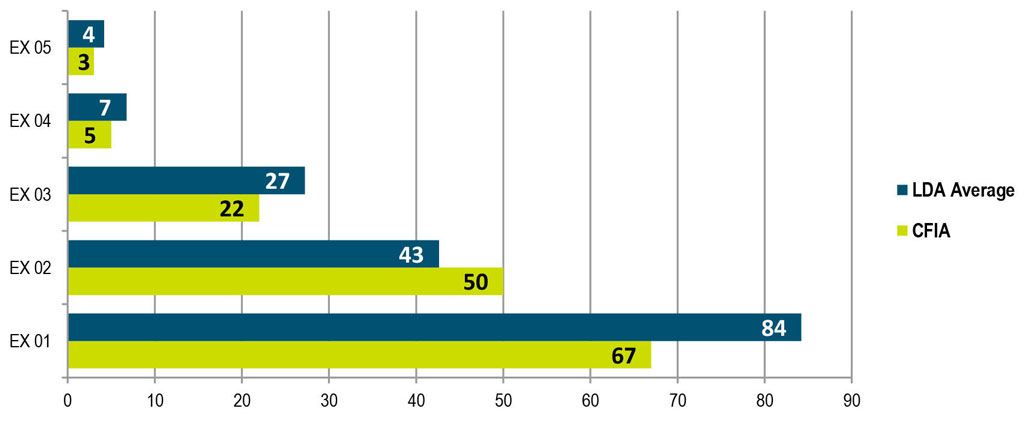
Description for EX distribution by level - Fiscal Year 2016-2017 (Q22)
| Title | EX-05 | EX-04 | EX-03 | EX-02 | EX-01 |
|---|---|---|---|---|---|
| Large Departments and Agencies Average | 4 | 7 | 27 | 43 | 84 |
| CFIA | 3 | 5 | 22 | 50 | 67 |
The Policy on Classification supports the equitable, consistent and effective establishment of the relative value of work in the core public administration. This ensures that jobs are classified appropriately in accordance with the relevant job evaluation standards. The Classification Program supports the sound management of the wage bill through appropriate classification decisions. Deputy heads may assign their classification authority to employees (accredited human resources advisors) in their organizations, in accordance with the requirements set out in the Policy on Classification and its instruments.
Departments and agencies should maximize the use of standardized job descriptions as they can assist in reducing the time and effort required to write, classify, and update job descriptions. Standardized job descriptions create efficiencies for recruitment, staffing, career development, and learning efforts. They also serve to facilitate mobility within occupational groups. Departments and agencies are expected to implement standardized job descriptions wherever possible, using unique job descriptions only on an exceptional basis.
Job descriptions must be reviewed regularly to ensure that they continue to reflect appropriately the work performed, and to reward employees fairly, equitably and appropriately. Such efforts allow employees to have clarity regarding their responsibilities and to feel recognized for their contributions to their organization and to Canadians. Regular reviews also allow departments to ensure that job descriptions enable staffing and support the preparation of performance, training, and career plans.
At CFIA, 65.5% of its positions have standardized job descriptions, a slight decrease (1.5 percentage points) from the previous year. In addition, 85.7% of the positions have classification decisions greater than five years.
All managers who authorize job descriptions, organizational charts or classification action requests are required to complete the Introduction to Organization and Classification (P930) required course. This training ensures that managers are aware of and able to carry out their organization's classification responsibilities, as sub-delegated by the deputy head. It also provides them with an appreciation of the impact their decisions have on employee engagement, on their organization's salary envelope, and on the overall Canadian Public Administration (CPA) wage bill.
As of March 31, 2017, only 3.7% of CFIA's managers who authorize job descriptions, organizational charts, or classification action requests have completed the required course. CFIA is encouraged to improve performance in this area.
Information Management & Information Technology (IM/IT)
Information, data, and technology enable the design and delivery of seamless, secure, and digitally enabled programs and services to Canadians. The Information Management/Information Technology (IM/IT) integrated Area of Management (AoM) assesses the overall management of information, data, and technology in departments and agencies. This AoM also provides, where possible, year-over-year comparisons in key areas of stewardship, program and service enablement, enterprise priorities, and workforce and leadership capacity.
IM Stewardship
Open and accessible information allows the Government of Canada (GC) to be responsive and accountable to Canadians. The adoption of designated corporate repositories (Electronic Documents Records Management Solutions (EDRMS)) supports departmental recordkeeping throughout the information lifecycle. This enables public servants to use information and data efficiently in support of evidence-based decision-making and deliver quality services internally and externally. The use of an EDRMS (e.g.; GCDocs) also advances Information Management (IM) practices through the proactive and ongoing release of GC data and information (Open by Default).
Through the Directive on Recordkeeping, departments and agencies are required to create, acquire, capture, manage, and protect the integrity of information resources of business value in the delivery of GC programs and services.
The percentage of unstructured electronic information resources maintained in designated corporate repositories contributes to the assessment of departmental IM maturity and is also used as a government-wide performance measure for the IM Internal Service.
Percentage of unstructured electronic information resources maintained in designated corporate repositories (Q1)
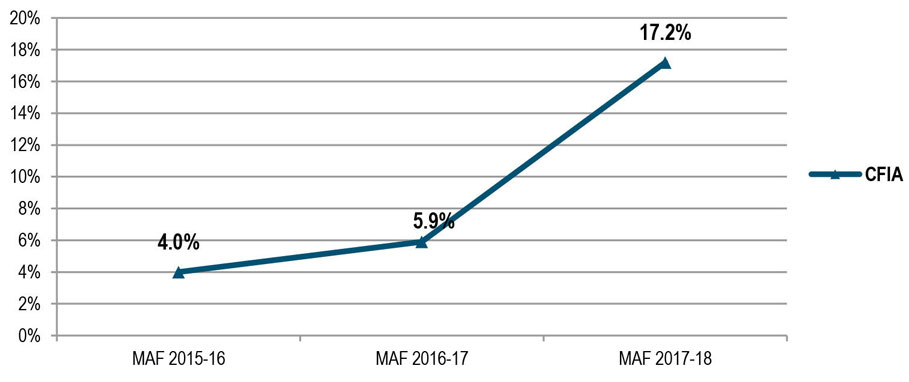
Description for Percentage of unstructured electronic information resources maintained in designated corporate repositories (Q1)
| Fiscal Year | Percent |
|---|---|
| 2015-16 | 4.0 |
| 2016-17 | 5.9 |
| 2017-18 | 17.2 |
The Canadian Food Inspection Agency (CFIA) has increased the percentage of unstructured electronic information maintained in its EDRMS to 17.2% from 5.9% in Fiscal Year 2016-2017. TBS encourages CFIA to continue its efforts in this area.
IM Program / Service Enablement
The Directive on Open Government requires departments and agencies to maximize the release of government information and data of business value to support transparency, accountability, citizen engagement, and socio-economic benefits through reuse, subject to applicable restrictions associated with privacy, confidentiality, and security.
The Government of Canada's commitment to openness is also intended to help create a more cost-effective, efficient, and responsive government for all Canadians.
The department or agency is expected to confirm that structural elements are in place to make data and information increasingly open by default, through the use of data governance, data management, data and information inventories, and other open government activities.
Is there a documented governance structure in place for data management? (Q2)
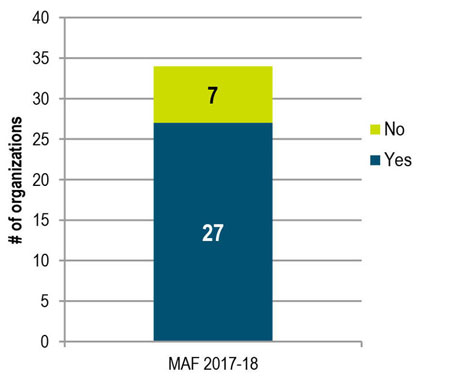
Description for Is there a documented governance structure in place for data management? (Q2)
The CFIA's response is yes for the Fiscal Year 2017-18.
| Response | Number of Organizations |
|---|---|
| Yes | 27 |
| No | 7 |
Has the inventory been updated since November 1, 2016? (Q3)

Description for Has the inventory been updated since November 1, 2016? (Q3)
The CFIA's response is yes for the Fiscal Year 2017-18.
| Response | Number of Organizations |
|---|---|
| Yes | 32 |
| No | 2 |
By updating its data inventory and releasing four datasets via open.canada.ca, CFIA has demonstrated that its data holdings support foundational elements of Open Government (OG) and GC initiatives on accountability, transparency, and informed decision-making.
Number of datasets released via open.canada.ca (Q4)

Description for Number of datasets released via open.canada.ca (Q4)
| Fiscal Year | Number of datasets released |
|---|---|
| 2015-16 | 0 |
| 2016-17 | 0 |
| 2017-18 | 4 |
CFIA has also submitted a documented data governance structure which demonstrates it is appropriately managing, protecting, and reusing data.
TBS encourages CFIA to continue its efforts in these areas.
IT Applications
The Government of Canada is committed to responsive and innovative Information Technology (IT) services that enable digital government, meet business needs, and enhance the end-user experience. It also seeks to ensure secure and resilient enterprise infrastructure that enables the trusted delivery of programs and services. The GC is committed to smart investments that ensure high-value and cost-effectiveness and to fostering an agile, connected, and high-performing workforce with modern tools.
The department or agency is expected to integrate IT as part of business planning, align with GC strategic goals, and balance enterprise and program-driven priorities (via IT plans, IT expenditure reporting, and Application Portfolio Management (APM) for aging and mission critical applications).
CFIA has not demonstrated the expected level of maturity in the practices of IT stewardship. CFIA should enhance the management of the health of its application portfolio by identifying aging IT issues and addressing them through life-cycle management, including planned retirements.
Application Portfolio Health Indicator (APHI) value for the department's inventory of applications (Q16)
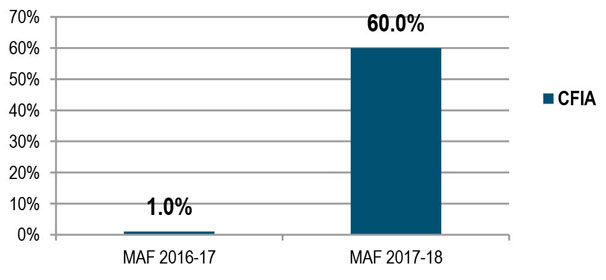
Description for Application Portfolio Health Indicator (APHI) value for the department's inventory of applications (Q16)
| Fiscal Year | Percent |
|---|---|
| 2016-17 | 1.0 |
| 2017-18 | 60.0 |
IT Enterprise Priorities Alignment
The Directive on Management of Information Technology (IT) requires departments and agencies to support the management of IT on a government-wide basis by implementing more agile, robust, and mature IT management practices. It reduces duplication, enables the adoption of alternate service delivery models (common and shared services), promotes alignment and interoperability, and optimizes open and accessible digital services for Canadians.
The department or agency is expected to demonstrate progress towards mature interoperability capabilities through the use of Application Program Interfaces (API).
The Chief Information Officer Branch strategy for "GC Service Oriented Architecture" provides guidance in the use and adoption of Service Oriented Architecture (SOA) across the federal government in order to deliver highly reusable and fully interoperable services, from high-level business concepts to supporting technology components. CFIA is expected to demonstrate alignment with SOA guidance and adoption of SOA in the development of departmental applications.
CFIA has demonstrated its use of SOA and Application Programming Interfaces (API) in application development activities.
TBS encourages CFIA to continue its efforts in these areas.
IT Infrastructure and Operations
The Directive on Management of Information Technology (IT) requires innovative and responsive services. The measurement of performance is essential in promoting efficient client-centric services that support departmental program-delivery objectives. This measurement is used to assess whether IT processes in organizations are operating in line with expectations, while also ensuring the health of IT systems through regular monitoring.
The department or agency is expected to meet service levels for resolving workplace technology device (WTD) related incidents (mean time to resolve), measure and report against documented service level agreements (SLAs), reduce overall support costs, and increase workforce productivity to deliver on programs and services.
CFIA has demonstrated the expected maturity in the management of IT infrastructure and operations performance. TBS encourages it to continue its efforts in this area.
Mean time to resolve (MTTR) for workplace technology device (WTD) related incidents (Q31)
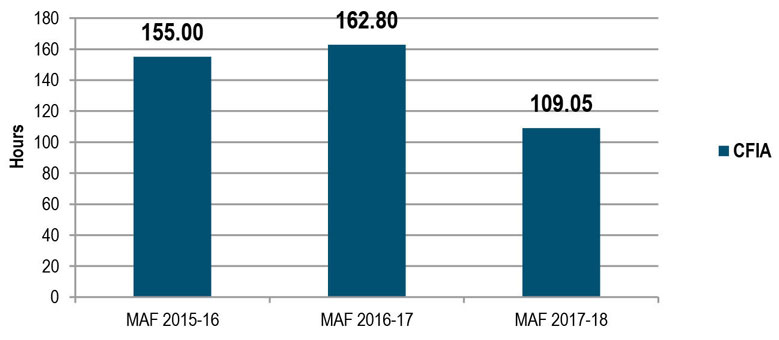
Description for Mean time to resolve (MTTR) for workplace technology device (WTD) related incidents (Q31)
| Fiscal Year | Hours |
|---|---|
| 2015-16 | 155 |
| 2016-17 | 162.8 |
| 2017-18 | 109.05 |
Percentage of incidents resolved by 1st level support for workplace technology device related incidents (Q32)

Description for Percentage of incidents resolved by 1st level support for workplace technology device related incidents (Q32)
| Fiscal Year | Percent |
|---|---|
| 2015-16 | 46 |
| 2016-17 | 46 |
| 2017-18 | 60.2 |
Results Management
The Results Management Area of Management (AoM) reflects the Government of Canada's priority to better inform expenditure management decisions with performance information and to achieve effective and efficient management across government. Performance measurement practices are assessed to provide a system-wide view of the extent to which departments and agencies create, use, and report on quality performance information. This information informs an organization's program management and decision making, so that its programs deliver the expected results and advance its mandate and priorities.
Availability of performance information for decision-making
Departments need to understand what is working and what is not and to make improvements to their programs accordingly. Availability of quality performance information is a first step in determining what results are being achieved and where resources are needed.
The Policy on Results sets out the requirements for having quality performance information for use in decision-making. Departments and agencies are expected to include quality evaluation and performance information in their proposals to Treasury Board to support the case for funding requests. Once a Treasury Board submission is approved, departments are required to collect all of the performance data they committed to in the submission.
The average quality of Treasury Board Submission Results Appendices submitted by Canadian Food Inspection Agency (CFIA) was assessed as "Fair" for draft submissions and "Good" for final submissions. CFIA should increase its efforts to ensure that it can produce high quality draft and final versions of Results Appendices for its Treasury Board Submissions.
Quality of Results Appendices and past performance information in first draft and final TB submissions submitted by the LDA (Q1 & Q2) - Management Accountability Framework 2017-18
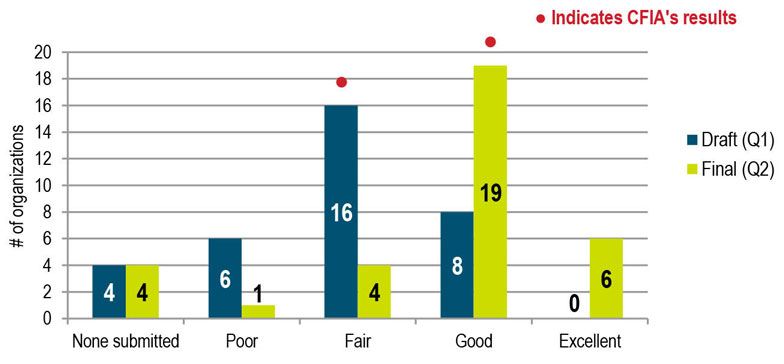
Description for Quality of Results Appendices and past performance information in first draft and final TB submissions submitted by the LDA (Q1 & Q2) - Management Accountability Framework 2017-18
The CFIA's response for draft submissions was fair. The CFIA's response for final submissions was good.
| Title | None submitted | Poor | Fair | Good | Excellent |
|---|---|---|---|---|---|
| Draft | 4 | 0 | 16 | 8 | 0 |
| Final | 4 | 1 | 4 | 19 | 6 |
The original indicator "What percentage of indicators in Results Appendices have been implemented?" could not be assessed due to missing data in appendices. Information on the level of implementation of short-term indicators and the capacity to implement all indicators are provided instead. CFIA committed to implement 34 performance indicators in its Treasury Board Submission Results Appendices between September 2016 and December 2016. Seven of these were listed as short-term indicators. CFIA has implemented 100% of these short-term indicators as of February 2018, which is above the LDA median of 53%. TBS is confident that CFIA is on track to implement all of its indicators.
Use of Performance Information in Decision-Making
The Policy on Results requires departments to use performance information and evaluations to make resource allocation decisions and improve their results. This is a crucial step for departments to realise the benefits of investments in performance measurement and evaluation.
CFIA has demonstrated that it "Often" uses performance measurement and evaluation information in its senior management resource allocation decisions. CFIA should expand its efforts to ensure these decisions use performance measurement and evaluation information.
Extent to which performance measurement and analysis, and evaluation findings and recommendations are factored into senior management resource allocation decisions (Q4 & Q5) - Management Accountability Framework 2017-18
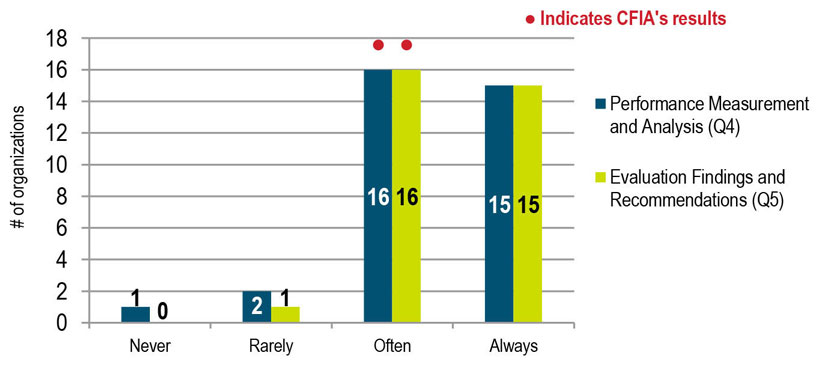
Description for Extent to which performance measurement and analysis, and evaluation findings and recommendations are factored into senior management resource allocation decisions (Q4 & Q5) - Management Accountability Framework 2017-18
The CFIA's response was often to both questions.
| Title | Never | Rarely | Often | Always |
|---|---|---|---|---|
| Performance measurement and analysis | 1 | 2 | 16 | 15 |
| Evaluation findings and recommendations | 0 | 1 | 16 | 15 |
CFIA completed 75% of its evaluation management plan items in the 2016-17 fiscal year. Half of assessed departments and agencies implemented more than 70% of their items. CFIA should ensure that more evaluation management plan items are implemented as scheduled in order to improve its programs.
Security Management
Sound and integrated security management supports the continuity and integrity of program and service delivery, contributing to the health, economic well-being, safety, and security of Canadians, while meeting the challenges of a dynamic and evolving risk environment.
The Security Area of Management assesses 20 departments and agencies and is intended to generate management performance information to help strengthen the overall security posture of the Government of Canada.
Effective and Integrated Security Management
A departmental security plan (DSP) sets out department-wide security risk mitigation strategies, identifies priorities for strengthening security practices and controls, and establishes a framework for monitoring and reporting on the achievement of security priorities and objectives. Meeting compliance and performance expectations of key management practices for departmental security planning is important as these practices contribute to and support departmental operational decision-making, effectiveness and accountability.
It is expected that departments and agencies have an approved DSP in place, that implementation progress and effectiveness of the DSP is reported to the deputy head, and that monitoring and reporting on the success of implementing planned security activities takes place.
The Canadian Food Inspection Agency (CFIA) has an approved Agency Security Plan (ASP), covering the current fiscal year. The deputy head was informed of ASP implementation progress, as well as of the effectiveness of the plan for 2016-17. Reporting could be strengthened by integrating performance measures to report on the effectiveness of the ASP. Of the activities planned for completion in 2016-17, 67% were carried out as planned. This completion rate indicates good success in managing department-wide security activities to achieve planned improvements.
Percentage of activities identified in the DSP that were planned for completion during the previous Fiscal Year and completed as planned (Q3)
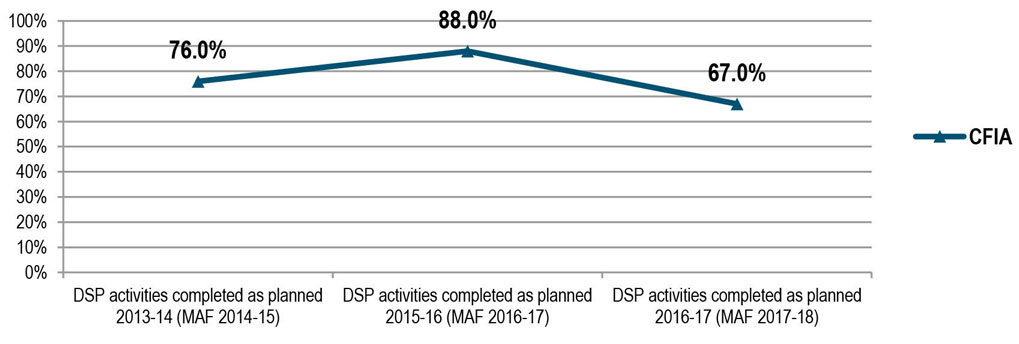
Description for Percentage of activities identified in the DSP that were planned for completion during the previous Fiscal Year and completed as planned (Q3)
| Fiscal Year | Percentage of DSP activities completed as planned |
|---|---|
| 2013-14 (Management Accountability Framework 2014-15) | 76.0 |
| 2015-16 (Management Accountability Framework 2016-17) | 88.0 |
| 2016-17 (Management Accountability Framework 2016-17) | 67.0 |
Security Controls and Practices
Business Continuity Planning
In the event of a disruption, business continuity plans (BCP) provide for the continued availability of services and associated resources and assets that are critical to the health, safety, security or economic well-being of Canadians, or the effective functioning of government.
It is expected that these plans are reviewed and tested as part of an established maintenance cycle. Department and agency performance expectations are evaluated within a two year timeframe to monitor the ability of organizations to maintain their BCPs and to remain current with the evolving risk environment, supporting the resiliency of their organization.
CFIA has demonstrated policy compliance for the business continuity planning requirements assessed. The Agency reports that all of its critical services (eight) have BCPs in place, and have all been updated in the last two years. CFIA has consistently tested or exercised 100% of its BCPs within acceptable timeframes. These results indicate that it has a mature readiness and resiliency posture in the event of a disruption and has practices in place to contribute to the continuity of its critical services.
Percentage of critical services with a BCP updated since April 1st, 2016 (Q6)

Percentage of critical services with a BCP that has been tested or exercised since April 1st, 2016 (Q7)
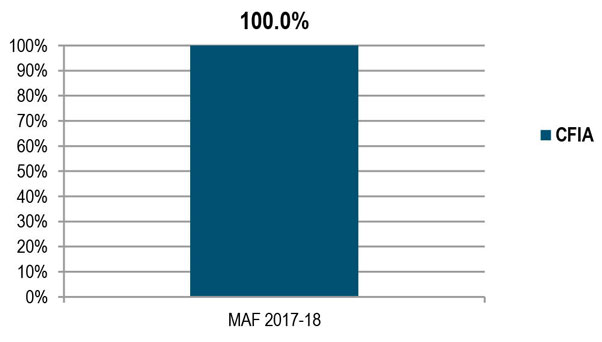
Physical Security
The goal of physical security control and related management practices is to detect and protect against unauthorized access and to mitigate risks related to workplace violence.
The Government of Canada supports a risk-based approach to the security management of departmental facilities. Security requirements of all facilities are expected to be defined. It is expected that facilities with higher security requirements have up-to-date security assessments.
Percentage of the organization's facilities with higher security requirements that have an up-to-date security assessment (Q9)
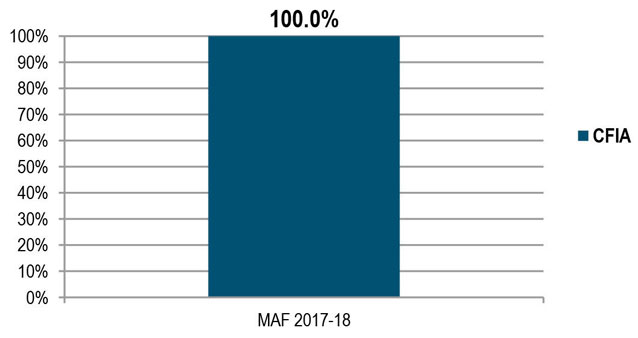
CFIA has demonstrated that it maintains sound risk management practices related to the assessment of its facilities in keeping with the physical security requirements of the Policy on Government Security (PGS), assessed in this Management Accountability Framework cycle. The Agency has demonstrated that it employs an established mechanism to identify facilities with higher security requirements. CFIA reported that 100% of its facilities with higher security requirements have a current security assessment in place. This demonstrates that the Agency's approach is reaching a mature state of maintaining risk-based physical security practices which contribute to the protection of people, information, and assets required for program and service delivery.
Information Technology Security
The formal authorization of applications supporting the delivery of a department or agency's critical services, as well as vulnerability management for Information Technology (IT) systems and applications, are key IT security practices which can mitigate risk exposure.
A) Mission Critical Applications
Applications that support the delivery of critical services are known as mission critical applications (MCAs). Understanding the overall effectiveness of security measures applied to MCAs is essential in determining and managing risks to these services. Mature risk management practices identify and track security risks, which are then accepted by business owners or mitigated through planned remediation activities and timelines.
Percentage of mission critical applications currently in operation that have been authorized for operation (Q10)
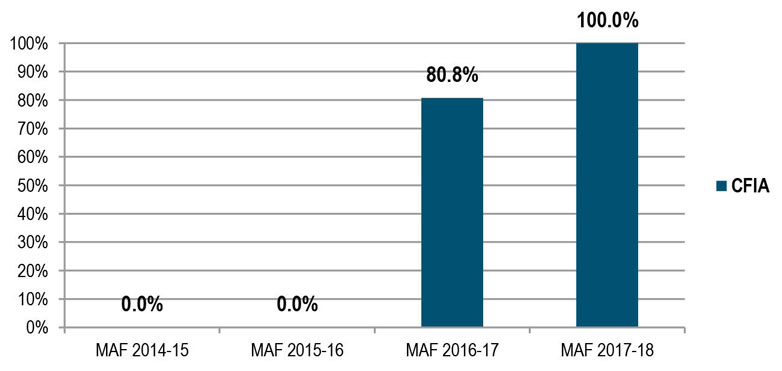
Description for Percentage of mission critical applications currently in operation that have been authorized for operation (Q10)
| Management Accountability Framework | Percent |
|---|---|
| 2014-15 | 0 |
| 2015-16 | 0 |
| 2016-17 | 80.8 |
| 2017-18 | 100 |
CFIA reported that 100% of its mission critical applications have been authorized for operation (28 MCAs). This result demonstrates that the Agency has assessed and understands the associated risks to its programs and services. CFIA has improved in this area of performance by 19 percent from the last Management Accountability Framework cycle. Of the authorized MCAs, all are operating under conditions which indicates that risks have not been mitigated or may be higher than acceptable for ongoing operations. The Agency reports that 21 of the 28 MCAs authorized with conditions have remediation plans to address residual risks. As well, CFIA is tracking progress against risk remediation plans and reports that 0% of remediation conditions within these plans have been met. Operating with all MCAs under conditions, where 75% have a remediation plan to address residual risk, demonstrates that CFIA is still in the process of establishing practices to ensure a complete understanding and management of risk mitigation requirements for applications supporting critical services. CFIA is encouraged to continue to establish practices to plan, implement, record and measure progress for risk remediation conditions for all its MCAs.
B) Security vulnerability assessment and patch management
The Government of Canada supports the Communications Security Establishment's (CSEC) Top 10 Security Actions to Protect Government of Canada Internet-Connected Networks and Information (ITSB-89 Version 3). CSEC recommends applying patches (software update to fix or improve a security vulnerability) to operating systems, applications and devices as a critical activity to ensure they are secure.
For the current fiscal year, it is expected that patch management is performed on all departmental systems or services within CSEC's recommended patch deployment timeframes. Once deployed, departments and agencies should have a documented patch management plan detailing the verification process that validates patches were properly installed.
Percentage of systems or services which have been patched against CSEC's recommended deployment time frames by risk level (Q14 to Q17) - Management Accountability Framework 2017-18
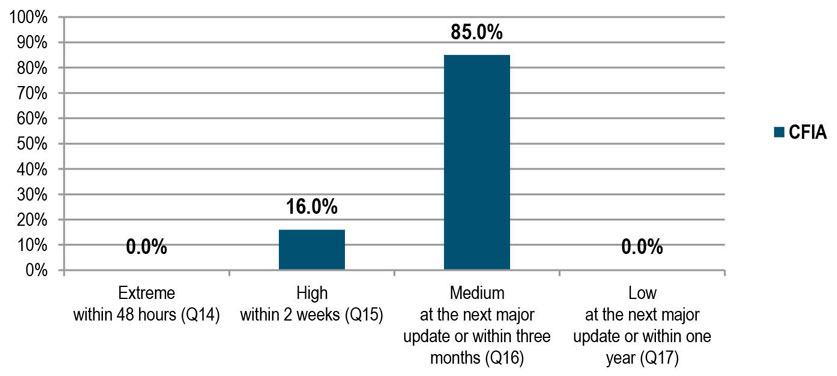
Description for Percentage of systems or services which have been patched against CSEC's recommended deployment time frames by risk level (Q14 to Q17) - Management Accountability Framework 2017-18
| Title | Percent |
|---|---|
| Extreme – within 48 hours | 0 |
| High – within 2 weeks | 16 |
| Medium – at the next major update or within 3 months | 85 |
| Low – at the next major update or within one year | 0 |
When measured against CSEC's recommended patch deployment timeframes, CFIA indicated deploying 16% of High and 85% of Medium risk patches within the recommended timeframes. CFIA is encouraged to improve its efforts to achieve 100% of systems patched within CSEC's recommended timeframes. Measuring the performance of systems that have been patched in a timely manner provides an indication of the agency's due diligence to protect GC assets.
Service Management
The effective management of government services contributes to value for money, produces high levels of client satisfaction, and promotes confidence in government. Through the Policy on Service and the Government of Canada (GC) Service Strategy, the GC is seeking to improve online services and establish new performance standards to promote a better client experience for Canadians.
The Service Area of Management (AoM) supports oversight on the Policy on Service, which aims to establish a more strategic and coherent government-wide approach to the design and delivery of services, including the establishment of robust service standards, ensuring the prevalence of online services, and the establishment of effective client feedback mechanisms.
Service Performance: Client-Centric Services Perspective
The Policy on Service requires that service standards for priority services be available to clients on Canada.ca for external services and on internal collaborative tools for internal enterprise services. Service standards establish expectations for the level of service clients are to receive and are a cornerstone in determining client satisfaction with GC services.
The department or agency is expected to design and deliver its services in a client-centric manner.
The following indicators outline the extent to which the department or agency has established publicly available service standards for priority services and how they are being met.
The Canadian Food Inspection Agency (CFIA) demonstrated that it has established service standards for 63% of its priority services, an increase from 35% in 2016-17 and that this is due to the establishment of new service standards for four priority services. However, the evidence provided by CFIA indicates that its service standards for priority services have not been reviewed and its targets have not been met.
TBS encourages CFIA to continue its efforts to establish, review and meet its service standards, and ensure that they are meaningful to clients.
Service Standards (Q4, Q5 and Q6)
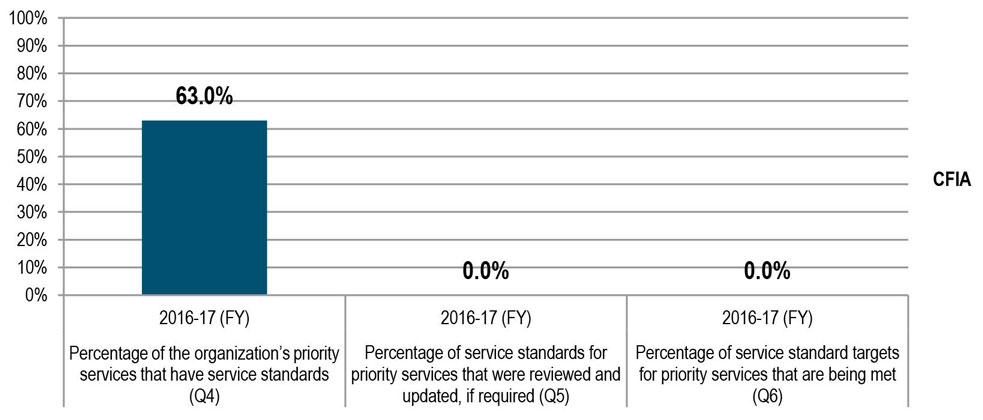
Description for Service Standards (Q4, Q5 and Q6)
| Title | Percent |
|---|---|
| Percentage of the organization's priority services that have service standards | 63 |
| Percentage of service standards for priority services that were reviewed and updated, if required | 0 |
| Percentage of service standard targets for priority services that are being met | 0 |
The Policy on Service requires that the proportion of external and internal enterprise services available online is increased annually.
Canadians and businesses expect access to convenient and secure end-to-end online services. In addition, on-line service delivery is significantly more cost-effective than delivery through traditional channels, such as in-person and telephone channels.
The following indicators outline the extent to which the organization is making its priority services available online.
CFIA's percentage of priority services that can be completed online from end-to-end increased slightly to 6%, from zero last year. This means that only one priority service (Establishment and Facility Registration - Food Dairy) out of 16 can be completed online from end-to-end.
Availability of Online Services (Q8, Q9)
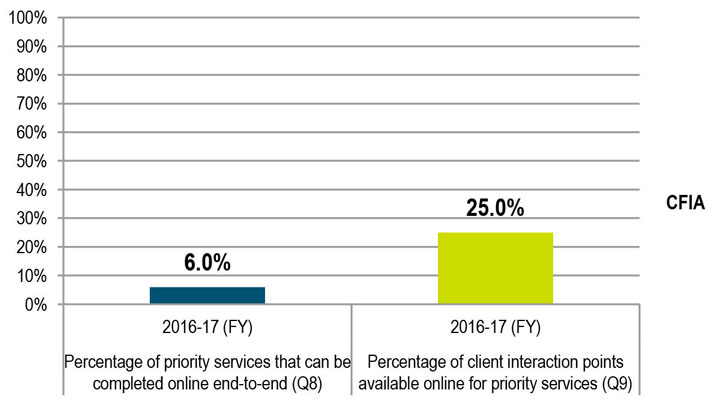
Description for Availability of Online Services (Q8, Q9)
| Title | Percent |
|---|---|
| Percentage of priority services that can be completed online end-to-end | 6 |
| Percentage of client interaction points available online for priority services | 25 |
In addition, CFIA has demonstrated that 25% of client interaction points for priority services are available online (new baseline).
Increasing the availability of online services is fundamental to client-centric services and TBS encourages the organization to continue its efforts in this area.
The Policy on Service requires departments and agencies to ensure that a mechanism to provide feedback and to address client service issues in a timely manner is available to clients.
The department or agency is expected to address client feedback in order to improve services. Monitoring client feedback is a good management practice that promotes service improvement and client centricity.
This indicator outlines the extent to which the organization is using client feedback to improve its priority services.
CFIA has not demonstrated that it has improved any of its priority services based on client feedback. TBS encourages the Agency to leverage client feedback to ensure that its services meet the needs and expectations of its clients.
Annex: Operational Context as provided by CFIA
During the 2017-18 Management Accountability Framework 2017-2018 assessment period, the Canadian Food Inspection Agency (CFIA) renewed its commitment to the following five strategic priorities: 1) Modern Regulatory Toolkit, 2) Integrated Risk Management, 3) Consistent and Efficient Inspections, 4) Digital-First Tools and Services, and 5) Global Leader.
The Agency engaged with stakeholders, industry, academia, other levels of the Canadian government and international partners, on various initiatives. Some of the initiatives that the Agency engaged with stakeholders on included the Safe Food for Canadians Regulations; the Humane Transport Regulatory Modernization initiative and the CFIA's proposed plan to streamline and update its approach to cost recovery. The CFIA collaborated with government, industry and others who play a role in safeguarding plant and animal health on the development of a Plant and Animal Health Strategy for Canada. This strategy offers a shared/collaborative vision and integrated approach to safeguarding plant and animal health in Canada.
Two changes were announced at the Agency in December 2017: a new governance structure and the creation of two new branches. The Innovation, Business and Service Development Branch lead by Vice President Amanda Jane Preece (the Agency's new Chief Information Officer) was created to better support the Agency in moving forward with its innovative agenda. A joint International Affairs Branch with Agriculture and Agri-Food Canada lead by Fred Gorrell, Assistant Deputy Minister, was created to provide a focus on international market access and regulatory trade.
Other changes in senior management included the appointment of France Pégeot as Executive Vice President of the Agency.
[Redacted paragraph]
- Date modified: